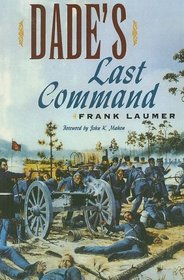While this is an interesting read I did have a few problems with it. First off, let me say I previously knew of the "Dade Massacre." I have been to that battlefield site and even seen the reenactment. As a Civil War reenactor myself, I knew many of the men who portrayed Dade's command in the reenactment event.
The back cover describes the men "who died violent and terrible deaths to perpetuate a political and social evil." And that evil was slavery. I have a problem with this, as the author also states half of the men in Dade's command were from Europe and most of the rest were from the northern states. As such, these men were simply following the orders given them. It may be the government's action in wanting to evict the Seminoles from Florida also supported slavery, but don't blame the men.
Plus, the author's style of writing does not make for an easy read. He also darts off on tangents numerous times before describing the battle itself. And he often repeats himself. I think I counted at least three times he describes at some length how the Seminole chiefs were 'forced' to touch the pen and sign away their lands. Once would have been enough.
And finally, with only three men in the command surviving the battle, he creates conversation between the officers, as well as their thoughts, which have no substance in fact. This after the command left on their final march before falling into the Seminole ambush. As the men who survived were enlisted, and one a slave, they had no knowledge on what the officers were thinking.
Still, it was a worthwhile read. The tangents the author branched out on were basically descriptions of the lives of many of the officers and some of the men who were in Dada's command and how they came to join the U.S. Army. So it did add some value to the book. It's just how he placed them that I had a problem with.
The back cover describes the men "who died violent and terrible deaths to perpetuate a political and social evil." And that evil was slavery. I have a problem with this, as the author also states half of the men in Dade's command were from Europe and most of the rest were from the northern states. As such, these men were simply following the orders given them. It may be the government's action in wanting to evict the Seminoles from Florida also supported slavery, but don't blame the men.
Plus, the author's style of writing does not make for an easy read. He also darts off on tangents numerous times before describing the battle itself. And he often repeats himself. I think I counted at least three times he describes at some length how the Seminole chiefs were 'forced' to touch the pen and sign away their lands. Once would have been enough.
And finally, with only three men in the command surviving the battle, he creates conversation between the officers, as well as their thoughts, which have no substance in fact. This after the command left on their final march before falling into the Seminole ambush. As the men who survived were enlisted, and one a slave, they had no knowledge on what the officers were thinking.
Still, it was a worthwhile read. The tangents the author branched out on were basically descriptions of the lives of many of the officers and some of the men who were in Dada's command and how they came to join the U.S. Army. So it did add some value to the book. It's just how he placed them that I had a problem with.




